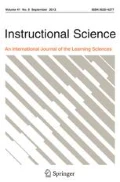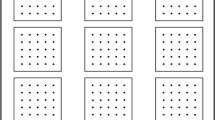Abstract
Conditions under which group work leads to learning have been studied in collaborative settings. Little is known, however, about whether and how the interplay between collaboration and cooperation impinges on group learning. In this paper, we study this interplay in the context of mathematical problem-solving. We focus on how training students to learn together influences this interplay, and on the relations of this interplay with mathematical problem-solving. Five groups of Grade 8 students participated in a course aimed at fostering learning to solve mathematical problems in small groups. Before and after the course, they solved a mathematical problem. An increase in the ratio of cooperation episodes out of total group work time was observed, as well as advancements in mathematical problem-solving. In addition, we found a mid-high correlation between instances of cooperation and mathematical activity: up to a certain threshold, cooperating more in a group yielded an increase in the individual generation of mathematical claims and arguments. We identified the critical role of coordination: for group learning to be productive, students should continuously negotiate and adjust their goals through communication before or while they cooperate on different tasks. We conclude that teachers aiming at fostering group work should encourage the diversification of modes of group work, for the advancement of mathematical problem-solving or of any case in which individual settings are too challenging.



Similar content being viewed by others
References
Abdu, R., Schwarz, B., & Mavrikis, M. (2015). Whole-class scaffolding for learning to solve mathematics problems together in a computer-supported environment. ZDM Mathematics Education,47(7), 1163–1178.
Anderson, R., Chinn, C., Chang, J., Waggoner, M., & Yi, H. (1997). On the logical integrity of children's arguments. Cognition and Instruction,15, 135–167.
Baghaei, N., Mitrovic, A., & Irwin, W. (2007). Supporting collaborative learning and problem-solving in a constraint-based CSCL environment for UML class diagrams. International Journal of Computer-Supported Collaborative Learning,2, 159–190.
Barron, B. (2000). Achieving coordination in collaborative problem-solving groups. Journal of the Learning Sciences,9(4), 403–436.
Barron, B. (2003). When smart groups fail. Journal of the Learning Sciences,12(3), 307–359.
Cifarelli, V. V., & Cai, J. (2005). The evolution of mathematical explorations in open-ended problem-solving situations. Journal of Mathematical Behavior,24(3–4), 302–324.
Claxton, G. (2004). Teaching children to learn: Beyond flat-packs and fine words. Burning issues in primary education no. 11. Birmingham: National Primary Trust.
Dawes, L., Mercer, N., & Wegerif, R. (2000). Thinking together: A programme of activities for developing thinking skills at KS2. Birmingham: Questions Publishing Company.
Derry, S. J., Pea, R. D., Barron, B., Engle, R. A., Erickson, F., Goldman, R., et al. (2010). Conducting video research in the learning sciences: Guidance on selection, analysis, technology, and ethics. Journal of the Learning Sciences,19(1), 3–53.
Dillenbourg, P. (1999). What do you mean by “collaborative learning”? In P. Dillenbourg (Ed.), Collaborative learning cognitive and computational approaches (Vol. 1, pp. 1–19). Oxford: Elsevier.
Dreyfus, T., Hershkowitz, R., & Schwarz, B. (2015). The nested epistemic actions model for abstraction in context: Theory as methodological tool and methodological tool as theory. Approaches to qualitative research in mathematics education (pp. 185–217). Dordrecht: Springer.
Fischer, F., Kollar, I., Stegmann, K., & Wecker, C. (2013). Toward a script theory of guidance in computer-supported collaborative learning. Educational Psychologist,48(1), 56–66.
Fredriksson, U., & Hoskins, B. (2007). The development of learning to learn in a European context. Curriculum Journal,18(2), 127–134.
Hammond, M. (2017). Online collaboration and cooperation: The recurring importance of evidence, rationale and viability. Education and Information Technologies,22(3), 1005–1024.
Hermann, F., Rummel, N., & Spada, H. (2001). Solving the case together: The challenge of net-based interdisciplinary collaboration. In First European Conference on Computer-Supported Collaborative Learning.
Hernández Leo, D., Asensio-Pérez, J. I., Dimitriadis, Y., Bote-Lorenzo, M. L., Jorrín-Abellán, I. M., & Villasclaras-Fernández, E. D. (2005). Reusing IMS-LD formalized best practices in collaborative learning structuring. Advanced Technology for Learning,2(3), 223–232.
Higgins, S., Wall, K., Baumfield, V., Hall, E., Leat, D., & Woolner, P. (2006). Learning to learn in schools phase 3 evaluation: Year two report. London: Campaign for Learning.
Iiskala, T., Vauras, M., Lehtinen, E., & Salonen, P. (2011). Socially shared metacognition of dyads of pupils in collaborative mathematical problem-solving processes. Learning and Instruction,21(3), 379–393.
Johnson, D. W., & Johnson, R. T. (1989). Cooperation and competition: Theory and research. Edina, MN: Interaction.
Johnson, D. W., & Johnson, R. T. (2002). Learning together and alone: Overview and meta-analysis. Asia Pacific Journal of Education,22, 95–105.
Kaddoura, M. (2013). Think pair share: A teaching learning strategy to enhance students' critical thinking. Educational Research Quarterly,36(4), 3–24.
Kapur, M. (2014). Productive failure in learning math. Cognitive Science,38(5), 1008–1022.
Kirschner, P. A., Sweller, J., & Clark, R. E. (2006). Why minimal guidance during instruction does not work: An analysis of the failure of constructivist, discovery, problem-based, experiential, and inquiry-based teaching. Educational psychologist,41(2), 75–86.
Koichu, B., Berman, A., & Moore, M. (2007). The effect of promoting heuristic literacy on the mathematical aptitude of middle-school students. International Journal of Mathematical Education in Science and Technology,38(1), 1–17.
Kontorovich, I., Koichu, B., Leikin, R., & Berman, A. (2012). An exploratory framework for handling the complexity of mathematical problem posing in small groups. Journal of Mathematical Behavior,31(1), 149–161.
Leont'ev, A. N. (1974). The problem of activity in psychology. Soviet Psychology,13(2), 4–33.
Lester, F. K. (1994). Musings about mathematical problem-solving research: 1970–1994. Journal for Research in Mathematics Education,25(6), 660–675.
Lester, F. K., & Cai, J. (2016). Can mathematical problem-solving be taught? Preliminary answers from 30 years of research. Posing and solving mathematical problems (pp. 117–135). Cham: Springer.
Liljedahl, P., & Santos-Trigo, M. (2019). Mathematical problem-solving. New York: Springer.
Lou, Y., Abrami, P. C., Spence, J. C., Poulsen, C., Chambers, B., & d’Apollonia, S. (1996). Within-class grouping: A meta-analysis. Review of Educational Research,66(4), 423–458.
Oner, D. (2013). Analyzing group coordination when solving geometry problems with dynamic geometry software. International Journal of Computer-Supported Collaborative Learning,8(1), 13–39.
Pólya, G. (1945). How to solve it: A new aspect of mathematical method. Princeton: Princeton University Press.
Roschelle, J., & Teasley, S. (1995). The construction of shared knowledge in collaborative problem-solving. Computer supported collaborative learning (pp. 69–97). Berlin: Springer.
Rowe, M. B. (1986). Wait time: Slowing down may be a way of speeding up! Journal of teacher education,37(1), 43–50.
Rummel, N., & Spada, H. (2005). Learning to collaborate: An instructional approach to promoting collaborative problem-solving in computer-mediated settings. The Journal of the Learning Sciences,14(2), 201–241.
Schneider, B. (2019). Unpacking collaborative learning processes during hands-on activities using mobile eye-trackers. In Paper presented in the 13th International Conference on Computer Supported Collaborative Learning. London, England.
Schoenfeld, A. H. (1985). Mathematical problem-solving. New York: Academic Press.
Schoenfeld, A. H. (2007). Problem-solving in the United States, 1970–2008: research and theory, practice and politics. ZDM-International Journal on Mathematics Education,39(5–6), 537–551.
Schwarz, B. B., Hershkowitz, R., & Prusak, N. (2010). Argumentation and mathematics. In C. Howe & K. Littleton (Eds.), Educational dialogues: Understanding and promoting productive interaction (pp. 115–141). New York: Routledge.
Schwarz, B. B., De Groot, R., Mavrikis, M., & Dragon, T. (2015). Learning to learn together with CSCL tools. International Journal of Computer-Supported Collaborative Learning,10(3), 239–271.
Sharan, S., & Shachar, H. (2012). Language and learning in the cooperative classroom. New York: Springer.
Smith, J. M., & Mancy, R. (2018). Exploring the relationship between metacognitive and collaborative talk during group mathematical problem-solving–what do we mean by collaborative metacognition? Research in Mathematics Education,20(1), 14–36.
Stahl, G. (2009). Studying virtual math teams. New York: Springer.
Toulmin, S. (1969). The uses of argument. Cambridge: Cambridge University Press.
Van den Bossche, P., Gijselaers, W., Segers, M., Woltjer, G., & Kirschner, P. (2011). Team learning: Building shared mental models. Instructional Science,39(3), 283–301.
Veenman, M. V., Wilhelm, P., & Beishuizen, J. J. (2004). The relation between intellectual and metacognitive skills from a developmental perspective. Learning and Instruction,14(1), 89–109.
Vogel, F., Kollar, I., Ufer, S., Reichersdorfer, E., Reiss, K., & Fischer, F. (2016). Developing argumentation skills in mathematics through computer-supported collaborative learning: The role of transactivity. Instructional Science,44(5), 477–500.
Webb, N. M., Franke, M. L., Ing, M., Wong, J., Fernandez, C. H., Shin, N., et al. (2014). Engaging with others’ mathematical ideas: Interrelationships among student participation, teachers’ instructional practices, and learning. International Journal of Educational Research,63, 79–93.
Wegerif, R. (2006). A dialogic understanding of the relationship between CSCL and teaching thinking skills. International Journal of Computer-Supported Collaborative Learning,1(1), 143–157.
Wegerif, R. (2015). Technology and teaching thinking. In The Routledge International Handbook of Research on Teaching Thinking (p. 427). Abingdon: Routledge.
Wegerif, R., & Mercer, N. (1997). A Dialogical framework for investigating talk. In R. Wegerif & P. Scrimshaw (Eds.), Computers and talk in the primary classroom (pp. 49–65). Clevedon: Multilingual Matters.
Wit, A. P. (2006). Interacting in task groups. In O. Hargie (Ed.), Handbook of communication skills (3rd ed., pp. 383–402). London: Routledge.
Acknowledgements
The present research was undertaken within the framework of the EU-funded Metafora Project (ICT-257872). The questionnaires were approved by the Chief Scientist of the Israel Ministry of Education, and by the ethical committee of the Hebrew University. We are indebted to the reviewers for their precious comments and for their encouragements.
Author information
Authors and Affiliations
Corresponding author
Ethics declarations
Conflict of interest
The authors declare that they have no conflict of interest.
Informed consent
This study received an authorization of the Israeli Ministry of Education. The parents/legal guardians of the students signed consent forms so the students were able participate in the activities and be filmed for this study.
Additional information
Publisher's Note
Springer Nature remains neutral with regard to jurisdictional claims in published maps and institutional affiliations.
Rights and permissions
About this article
Cite this article
Abdu, R., Schwarz, B. Split up, but stay together: Collaboration and cooperation in mathematical problem solving. Instr Sci 48, 313–336 (2020). https://doi.org/10.1007/s11251-020-09512-7
Received:
Accepted:
Published:
Issue Date:
DOI: https://doi.org/10.1007/s11251-020-09512-7




